The NVIDIA GeForce GTX 980 Ti Review
by Ryan Smith on May 31, 2015 6:00 PM ESTOverclocking
Finally, no review of a high-end video card would be complete without a look at overclocking performance.
From a design standpoint, GTX 980 Ti already ships close to its power limits. NVIDIA’s 250W TDP can only be raised another 10% – to 275W – meaning that in TDP limited scenarios there’s not much headroom to play with. On the other hand with the stock voltage being relatively low, in clockspeed limited scenarios there’s still some room for pushing the performance envelope through overvolting. And neither of these options addresses the most potent aspect of overclocking, which is pushing the entire clockspeed curve higher at the same voltages by increasing the clockspeed offsets.
GTX Titan X by comparison ended up being a good overclocker, and while we'd expect GTX 980 Tis to use slightly lower quality chips as part of the binning process, it should still overclock rather well.
| GeForce GTX 980 Ti Overclocking | ||||
| Stock | Overclocked | |||
| Core Clock | 1000MHz | 1250MHz | ||
| Boost Clock | 1075Mhz | 1326MHz | ||
| Max Boost Clock | 1202MHz | 1477MHz | ||
| Memory Clock | 7GHz | 8GHz | ||
| Max Voltage | 1.187v | 1.23v | ||
Overall we're able to get another 250MHz (25%) out of the GTX 980 Ti's GPU, and another 1GHz (14%) out of its VRAM. This pushes the GTX 980 Ti's clockspeeds up to 1326MHz for the standard boost clock, and 1477MHz for the maximum boost clock. The card is heavily TDP limited at this point, so it's unlikely to sustain clockspeeds over 1400MHz, but working clockspeeds in the 1300MHz range are certainly sustainable. Meanwhile interestingly enough, this is actually a slightly better overclock than what we saw with the GTX Titan X; the Titan was only able to get another 200MHz out of its GPU and 800MHz out of its memory. So GTX 980 Ti ends up being the better overclocker by 50MHz.
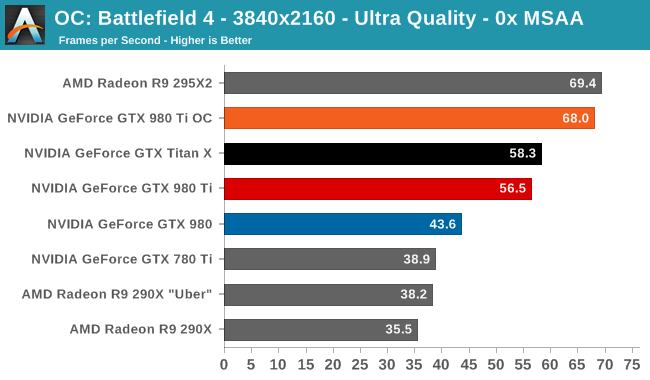
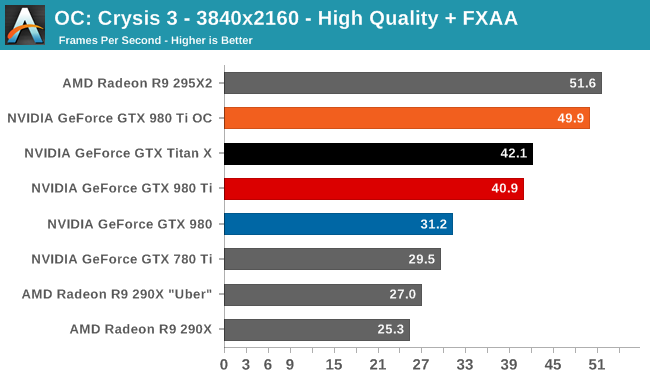
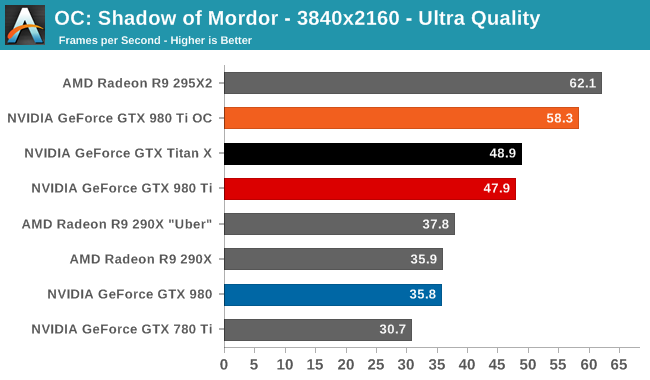
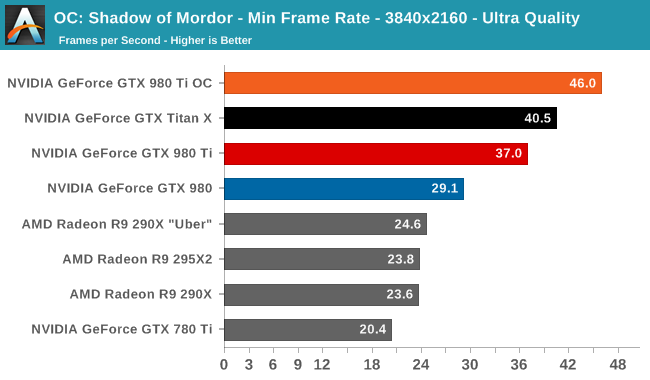
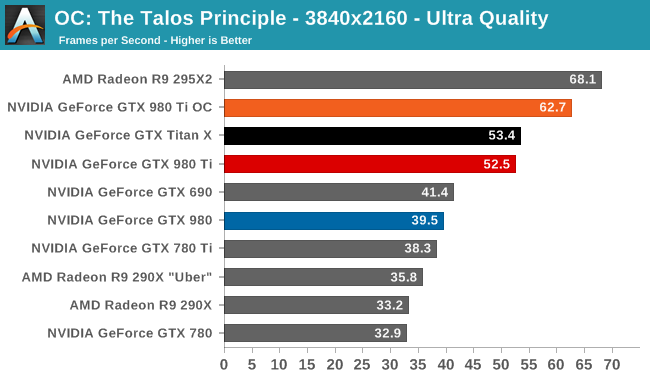
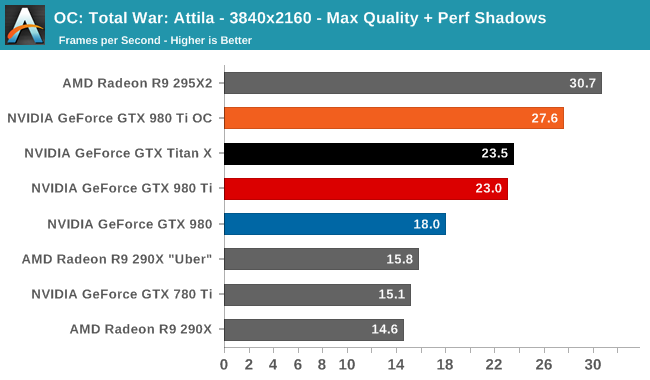
The gains from this overclock are a very consistent across all 5 of our sample games at 4K, with the average performance increase being 20%. Though not quite enough to push the GTX 980 Ti above 60fps in Shadow of Mordor or Crysis 3, it is enough to crack 60fps on Battlefield 4 and The Talos Principle.
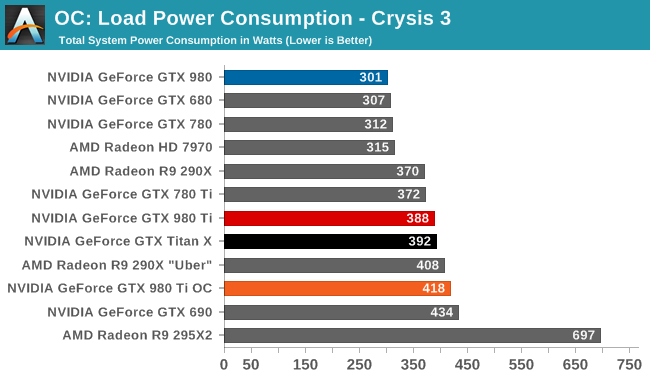
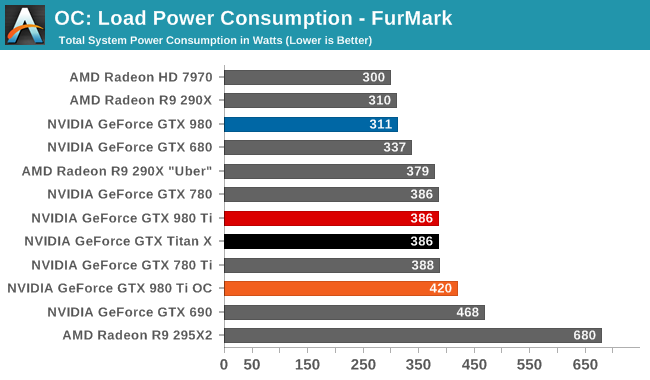
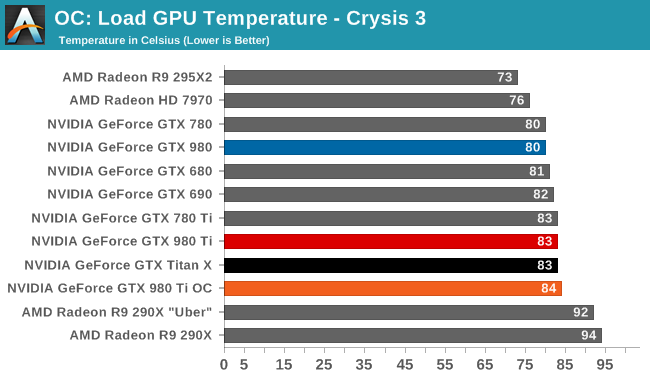
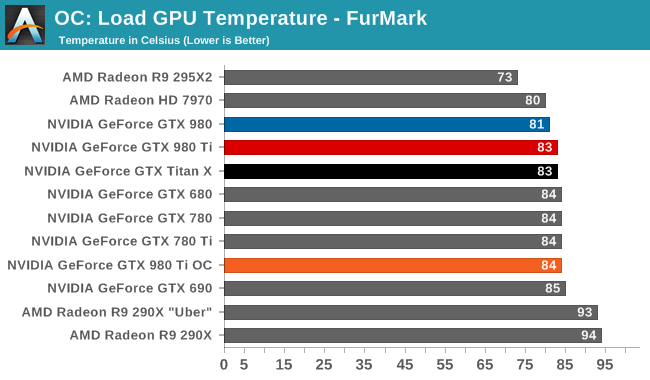
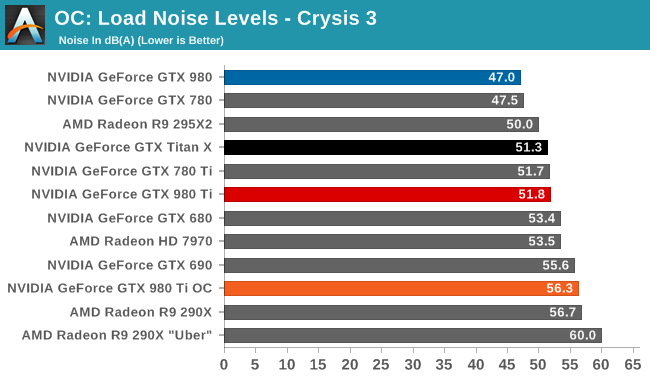
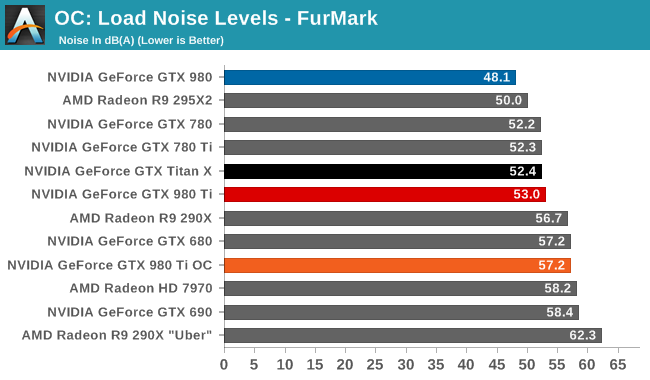
The cost of that 20% overclock in terms of power and noise is similarly straightforward. You're looking at an increased power cost of 30W or so at the wall – in-line with the 25W increase in the card’s TDP – while on the noise front the GTX 980 Ti is pushed out of its sweet spot. Card noise levels will increase by around 4.5dB(A).










290 Comments
View All Comments
ComputerGuy2006 - Sunday, May 31, 2015 - link
Well at $500 this would be 'acceptable', but paying this much for 28nm in mid 2015?SirMaster - Sunday, May 31, 2015 - link
Why do people care about the nm? If the performance is good isn't that what really matters?Galaxy366 - Sunday, May 31, 2015 - link
I think the reason people talk about nm is because a smaller nm means more graphical power and less usage.ComputerGuy2006 - Sunday, May 31, 2015 - link
Yeah, we also 'skipped' a generation, so it will be even a bigger bang... And with how old the 28nm is, it should be more mature process with better yields, so these prices look even more out of control.Kevin G - Monday, June 1, 2015 - link
Even with a mature process, producing a 601 mm^2 chip isn't going to be easy. The only larger chips I've heard of are ultra high end server processors (18 core Haswell-EX, IBM POWER8 etc.) which typically go for several grand a piece.chizow - Monday, June 1, 2015 - link
Heh, I guess you don't normally shop in this price range or haven't been paying very close attention. $650 is getting back to Nvidia's typical flagship pricing (8800GTX, GTX 280), they dropped it to $500 for the 480/580 due to economic circumstances and the need to regain marketshare from AMD, but raised it back to $650-700 with the 780/780Ti.In terms of actual performance gains, the actual performance increases are certainly justified. You could just as easily be paying the same price or more for 28nm parts that aren't any faster (stay tuned for AMD's rebranded chips in the upcoming month).
extide - Monday, June 1, 2015 - link
AMD will launch the HBM card on 400 series. 300 series is an OEM only series. ... just like ... wait for it .... nVidia's 300 series. WOW talk about unprecedented!chizow - Monday, June 1, 2015 - link
AMD already used that excuse...for the...wait for it...8000 series. Which is now the...wait for it....R9 300 OEM series (confirmed) and Rx 300 Desktop series (soon to underwhelm).NvidiaWins - Thursday, June 18, 2015 - link
RIGHT! AMD has been backpedaling for the last 3 years!Morawka - Monday, June 1, 2015 - link
980 was $549 at release.. So was the 780Nvidia is charging $650 for the first few weeks, but when AMD's card drops, you'll see the 980 Ti get discounted down to $500.
Just wait for AMD's release and the price will have to drop.